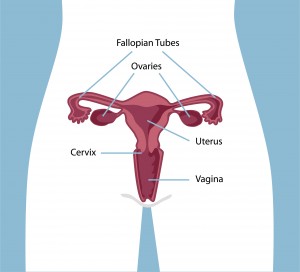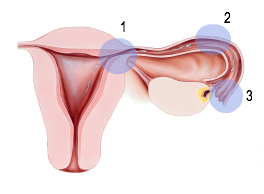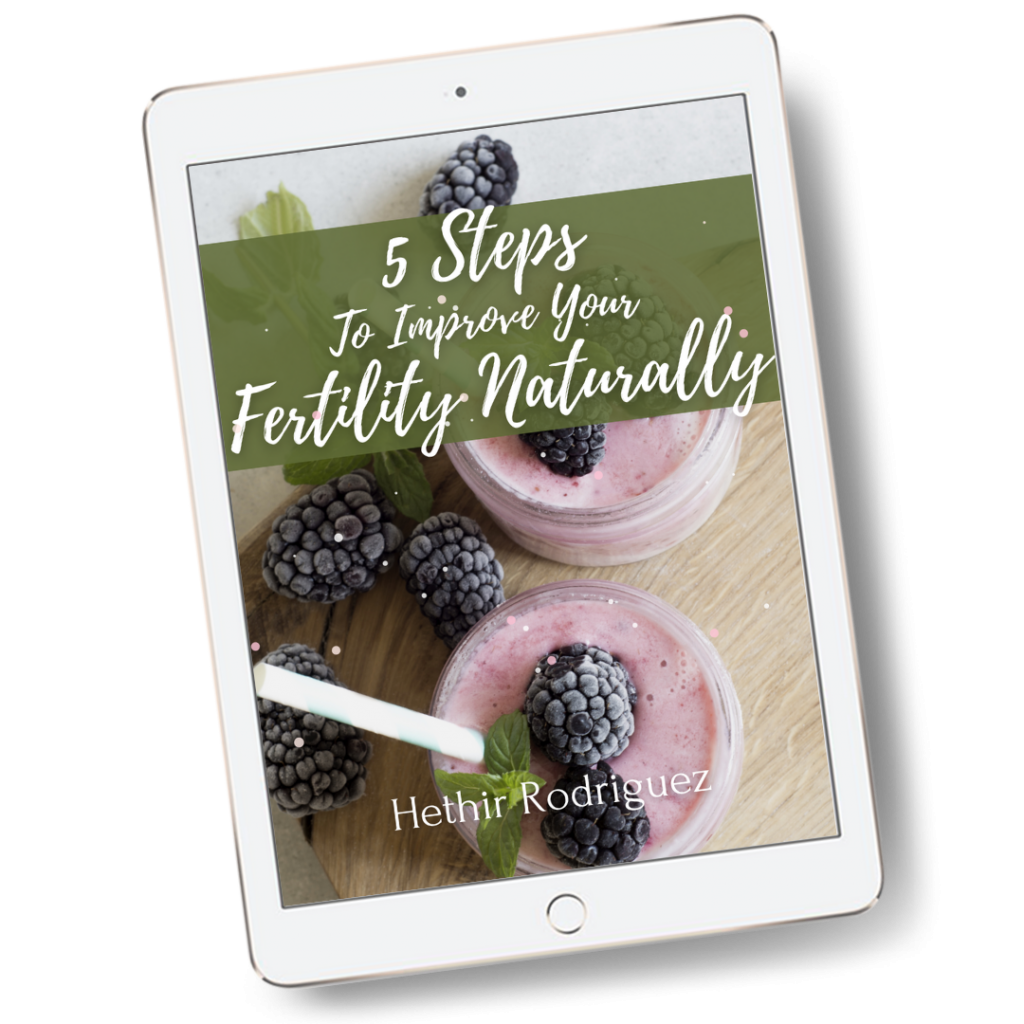While there are many causes of infertility, a blockage of the fallopian tubes is often the reason why many women are unable to conceive. The fallopian tubes are the pathways in which the ova travel from the ovaries down into the uterus, and if there is a blockage in these tubes it can prevent this from occurring. In this article, we’ll go over the causes of blocked fallopian tubes, medical procedures commonly used to unblock fallopian tubes, and natural therapies for fallopian tube health including fertility cleansing, systemic enzyme therapy and self-fertility massage.
The fallopian tubes can sometimes become blocked or even damaged due to certain conditions that a woman may experience. In rare cases, the blockage to the fallopian tubes may have been present since birth as a birth defect, but has gone undetected until the woman reached adulthood and tried to conceive.
Get to Know Your Fallopian Tubes

The fallopian tubes connect to the uterus at the utero-tubal junction where the fallopian tubes open into the uterine cavity. These very thin tubules are lined with cilia, which are fine hair-like cells. From there they extend out and slightly around toward the ovaries on both sides of the female body.
The fallopian tubes are described in sections for medical reference. The infundibulum is the end near the ovary that is associated with the fimbriae. The fimbriae is a fringe of tissue at the distal end (opening side toward the ovary) of the fallopian tubes. The fimbriae are covered in cilia, which look like tiny hairs. Just prior to ovulation sex hormones signal the fimbriae to fill with blood and move to touch the ovary in a gentle sweeping motion. When an oocyte (ova) is released at ovulation, the fimbria and cilia sweep the oocyte into the fallopian tube to be moved toward the uterus after fertilization.
The ampullary is the section of lateral tube (central section moving toward the uterus). The ampullary is the main part of the fallopian tube. From there, moving inward toward the uterus the tube narrows into what is known as the isthmus. The isthmus is the part of the muscle of the uterus that opens into the uterus at the utero-tubal junction.
Cells of the Fallopian Tubes are Affected by Hormones
There are two types of cells within the fallopian tubes. Ciliated cells are most abundant in the infundibulum and ampullary. Estrogen increases the production of cilia cells in the fallopian tubes. Scattered between the ciliated cells are peg cells which produce tubular fluid. This fluid contains important nutrients for both sperm, oocytes (ova), and zygotes (fertilized ova). The secretions also promote capacitation of the sperm. You may not know it, but the sperm cannot mature for complete fertilization without this important fluid. Studies published in BJOG, An International Journal of Obstetrics & Gynaecology, note that in may cases of blocked fallopian tubes both secretory and ciliated cells are dead or missing. Progesterone increases the number of peg cells. Estrogen increases the height and secretory activity of the peg cells. In addition, tubal fluid flows against the action of the cilia, near the fimbriated end. Not only is progesterone and estrogen balance vital to the menstrual cycle overall, but it is vital to the health and proper function of the fallopian tubes as well.
Causes of Blocked Fallopian Tubes
Location and Types of Blockages

1. Proximal 2. Midsegment 3. Distal
There are different types of fallopian tube blockages. Because the fallopian tubes have different sections and are a tube, there may be different areas of the blocked tube. Each section has its own name. Doctors have also come to find out that there are patterns of disease or trauma that may affect certain parts of the fallopian tubes more than others.
Proximal tubal occlusion involves the isthmus. This can occur after infection such as complications from abortion, missed miscarriage, cesarean section or PID. Permanent birth control procedures like Essure block the isthmus.
Midsegment tubal obstruction of the ampullary is most often due to tubal ligation damage. Tubal ligation is a surgical procedure to permanently prevent pregnancy. Some women who have had tubal ligation change their mind later in life and choose to have this procedure reversed. This can be done surgically and has a 75% pregnancy success rate. Tubal ligation reversal comes with its own risk for development of more scar tissue on top of scar tissue already present from the initial tubal ligation procedure.
Distal tubal occlusion is the type of blockage that affects the part of the fallopian tube end towards the ovary. This type of blockage is typically associated with hydrosalpinx (dilated and fluid-filled tube). Hydrosalpinx is often caused by Chlamydia trachomatis infection, which is a sexually transmitted disease. Untreated Chlamydia is known to cause both pelvic and fallopian tube adhesions.
In less severe cases only the fimbriae may be damaged. They may become stuck together in masses or may be damaged enough to no longer function as they should. As we learned above, the fimbriae have the important role of sweeping the oocyte (ova) into the fallopian tube for fertilization. If they no longer function then the oocyte never makes it to its destination for fertilization.
Common conditions that may cause blocked fallopian tubes are:
- Endometriosis
- Pelvic Inflammatory Disease (PID)
- Uterine Fibroids
- Ectopic pregnancy
- Tubal Ligation Reversal
- Complications from lower abdominal surgery such as Cesarean section
- Genital Tuberculosis (still common in developing countries, especially India)
Endometriosis and Fibroid tumors are both conditions which are becoming more prevalent in women every year. In fact, an astounding 13.6 million women in the United States alone suffer from mild to severe endometriosis.
Pelvic inflammatory disease is another common condition and is an umbrella term for a number of different problems that create an inflammatory infection in the female reproductive system. PID is almost always the direct result of a sexually transmitted disease, such as gonorrhea or chlamydia, and is responsible for about 100,000 cases of female infertility per year.
All of these conditions can cause blockage to the fallopian tubes by causing adhesions and scar tissue to form inside the path of the tube. The fallopian tubes may also become stuck to other parts of the internal body; the bladder, ovaries, uterus, bowels, etc. Damaged fallopian tubes can become twisted or the walls of the tubes themselves may adhere together causing a total blockage.
Partially damaged fallopian tubes may remain open enough for pregnancy to occur, but a partial blockage increases the risk for ectopic pregnancy. The fallopian tubes are very thin to begin with, so it does not take much for them to become blocked, preventing the ova from traveling through. As explained in the journal Human Reproduction Update (Volume 12, Issue 4, July/August 2006), studies have shown that low progesterone levels, smoking and use of fertility medications may alter how the fallopian tubes function, which increases the risk for ectopic pregnancy. Any of the conditions above may cause a partial tubal blockage as well, which also increases the risk for ectopic pregnancy.
Diagnosing Blocked Fallopian Tubes
There really are no outward signs that will let you know if you are suffering from blocked fallopian tubes. If you have ever suffered from pelvic inflammatory disease, there is a 15%-50% chance that your fallopian tubes are blocked.
The primary indicator that there is a blockage is an inability to conceive. Fortunately, there are diagnostic tests that can detect any abnormalities or blockages if there is evidence of some type of blockage to the tubes. The Journal of Human Reproductive Sciences explains diagnostic tests very well in their Jan.-June 2009 edition (see a link to this in the reference list for detailed explanations), but here are summaries on how blocked fallopian tubes are diagnosed…
Hysterosalpingogram (HSG)
Hysterosalpingogram is an X-ray test, using a contrast dye to view any obstruction in the fallopian tubes. The dye is inserted through a thin tube that is placed up through the vagina, into the uterus. Filling the uterus with this dye will then spill into the fallopian tubes. X-rays are then taken to determine if there is an injury or abnormal shape of the uterus and fallopian tubes, including obstruction in the tubes. This test is the number one test performed to determine if there is a blockage in the fallopian tubes.
Chromotubation
This test is similar to hysterosalpingogram because chromotubation includes dye being passed into the uterus and fallopian tubes as well. This test is performed during laparoscopy so that doctors can see the dye spilling from the fallopian tube. The dye used for this procedure cannot be seen on an X-ray, it is blue in color. This test is considered the most reliable way to determine fallopian tube blockage but does require surgery. It is not the initial test performed unless there is another reason to perform surgery such as chronic pelvic pain.
Sonohysterography
This is a non-invasive procedure where ultrasound imaging is used to determine if there are any abnormalities of the reproductive organs. This type of test is not always a reliable way to determine fallopian tube blockage since the tubes are so small and spillage of the fluid cannot always be seen on ultrasound. This test may help to determine hydrosalpinx or other issues such as uterine fibroids.
Medical Procedures to Open Blocked Fallopian Tubes
Thousands of women are diagnosed with blocked fallopian tubes each year and the number one question on their minds…how can I reopen them? There are many options for healing the fallopian tubes and in many cases, they can become open once again. It is important to recognize that the fallopian tubes are about the size of a pencil in circumference. Once they are damaged it may be difficult to reverse that damage. They are very delicate. Any sort of trauma can alter their function and damage the tubal tissues. Below are a variety of medical options for reopening the fallopian tubes.
Surgical Options
Tubal surgical procedures can either be done by open abdominal surgery or laparoscopy (small incision).
Salpingectomy
This procedure is the removal of part of the fallopian tube. This is commonly performed for hydrosalpinx prior to IVF. According to Fertility and Sterility, untreated hydrosalpinx makes IVF half as likely to be successful.
Salpingostomy
This procedure is performed when the end of the fallopian tube is blocked by hydrosalpinx. The surgeon creates a new opening in the fallopian tube entrance nearest the ovary. The success of this procedure is often temporary and often scar tissue reforms causing another blockage within 3-6 months of the procedure.
Fimbrioplasty
This option may be performed on women with damage to the fimbriae. If the fimbriae and its cilia are stuck together by scar tissue, which is preventing the ova from being picked up, a fimbrioplasty may be recommended. This procedure rebuilds the fimbriae. Very few doctors are experts in this type of procedure and medical insurance often does not cover the cost of this procedure. Fimbrioplasty is now recommended in select cases over salpingostomy, which has been shown to be less successful.
The above procedures have about a 20-30% pregnancy success rate.
Selective tubal cannulation
This procedure is performed for proximal tubal occlusion (where the tube meets the uterus). Guided by hysteroscopy or fluoroscopy, doctors insert a catheter through the cervix, uterus and into the fallopian tube. This is a minimally-invasive surgical procedure that has a 60% pregnancy success rate.
Tubal ligation Reversal,
Reversal of a tubal ligation, known as tubal reanastomosis, is a surgical procedure that is done with the assistance of a microscope and is generally performed in a hospital setting or outpatient surgical facility under general anesthesia. The surgeon removes the portion of the fallopian tube that was tied or cauterized in the original surgery and reattaches the two ends to make a complete tube. This procedure has a 75% pregnancy success rate.
During surgery doctors may clip away adhesions from the fallopian tubes, ovaries and uterus so the reproductive organs can move freely once again.
Risks for Fallopian Tube Surgery and Procedures
- Regrowth of scar tissue and adhesion. Any kind of surgery runs the risk of these types of formations. The tubes may become blocked again or adhered to the abdominal wall, other parts of the reproductive organs, or other organs in the surrounding location, for example, the bladder. Scar tissue may also form on other parts of the abdominal cavity, including the reproductive organs due to the surgical procedure.
- Opening the abdomen runs the risk of pelvic infection.
- Ectopic pregnancy.
While surgery is a common treatment for blocked fallopian tubes, there are natural options which can have great results without causing additional scar tissue to form.
Natural Therapies for Fallopian Tube Health
1. Fertility Cleansing
Fertility cleansing helps to cleanse the entire reproductive system and increase circulation to the reproductive organs. Starting your natural fallopian tube therapy should begin with fertility cleansing. The herbs in this cleanse are absorbed into the body and go to work where they are needed. Fertility Cleansing creates a “clean slate” within the body that helps the body to respond and utilize other natural remedies better.
2. Systemic Enzyme Therapy
Systemic Enzyme Therapy is a method for helping the body clear itself of excess tissue, breakdown scar tissues, cleanse the blood, increase circulation to the reproductive organs and reduce immunological response. Enzyme therapy consists of using systemic enzymes (enzymes naturally found in the body) to help the body reduce inflammation, occasional pain, reduce scar tissue build up and more. Traditionally systemic enzymes have been used by athletes to help them recover, elderly wanting to reduce the effects from arthritis, people suffering from autoimmune issues and the list goes on.
Systemic Enzyme Therapy may help to reduce the scar tissue that is blocking your fallopian tubes. Specific systemic enzymes help to eat away and reduce fibrin (the material that makes up scar tissue) over time. This type of therapy is extremely promising for helping the body to reduce excessive scar tissue formation and inflammation.
3. Abdominal or Fertility Massage
Massage is another natural therapy that could help support fallopian tube health. Massage helps to increase circulation and break up adhesions. Massage provides a great non-intrusive option for women with blocked fallopian tubes.
Benefits of Massage for Fallopian Tube Health:
- Helps the body to clear blocked fallopian tubes*
- Massage helps to break up scar tissue*
- Increased circulation aids in tissue elimination*
- Helps to reduce inflammation*
- Helps the body to loosen tight or twisted tissues*
Self Fertility Massage™
Self Fertility Massage is a series of massage techniques that are used to help support reproductive health, the menstrual cycle, and your fertility all from the comfort of your own home! This type of massage is easy to learn, perform and is cost effective!
One of the possible benefits of massage is the ability to break up adhesions. Adhesions are comprised of scar tissue. These adhesions are what cause the fallopian tubes to become blocked, stuck together, stuck to other parts of the reproductive organs or other internal tissues of the body. Self Fertility Massage™ gently helps to break up adhesions and increase circulation to detoxify and restore optimal function to the reproductive organs, including the fallopian tubes. Massage provides a great non-intrusive option for women with blocked fallopian tubes.
Clear Passages Therapy
Clear Passages uses hands-on physical therapy techniques known as the Wurn Technique to unblock fallopian tubes. This technique is done without the use of drugs or surgery. There are many studies proving the success of this technique for naturally unblocking the fallopian tubes. These studies were published in 2004, 2006, 2008 and 2015 in the peer-reviewed journal Alternative Therapies in Health and Medicine. Clear Passages has clinics in 7 locations in the United States and 2 in the UK. Women from all over the world travel to be treated in their clinics.
According to a study published in Alternative Therapies in Health and Medicine (2008), the Wurn Technique had a 61% success rate in opening blocked fallopian tubes that were totally blocked. The results of this therapy last many years in most cases, as compared to surgical procedures which usually regrow scar tissue and cause the fallopian tube/s to become blocked once again in approximately 6 months after the surgical procedure.
Clear Passages has success with their techniques in opening blocked fallopian tubes in women with…
- Two completely blocked fallopian tubes
- One blocked fallopian tube, one tube previously removed
- Hydrosalpinx (fluid filled tube)
- Distal end blockage (distal tubal occlusion, end near ovary)
Contact them to ask about the cost of an individualized session based on your health history.
Mercier Therapy
Created by Dr. Jennifer Mercier, Mercier Therapy is a deep pelvic organ visceral manipulative technique in which the reproductive organs are mobilized and blood flow restored. Organ restrictions are relieved and movement replenished amongst the organs and surrounding structures to enhance their natural and most optimal function.”
Mercier Therapy packages are called the Shared Journey Fertility Program which consists of an initial consult that includes a health history review and pelvic organ mobility test. Should the program be the right fit for the client than the cost of all of the sessions, including supplements and one full year of cycle monitoring is $2250.00.
In the words of Dr. Mercier, “I believe that women with past infection or tubal reversal can produce scar tissue or mucous plugs and with deep manipulation, we can bring a positive change to the tubes.”
The Arvigo Technique of Maya Abdominal Massage™
Developed by Dr. Rosita Arvigo, this holistic pelvic care approach uses techniques taught to Dr. Avigo by her mentor Don Elijio Panti, who was a Mayan Shaman in Belize, Central America. Dr. Arvigo spent 10 years learning these ancient massage techniques. Thousands of practitioners around the world are trained and perform Maya Abdominal Massage™ in their clinics.
This type of massage has been found to work to loosen and aid the body in the removal of old scar tissue and adhesion formation, which may be causing the reproductive organs to become stuck together, or to other parts of the internal body.
One session, depending on the amount of time spent, may cost anywhere from $70 to $100 per session. Prices may vary depending on the practitioner.
4. Castor Oil Therapy
Castor oil therapy has been used for centuries for helping with healing issues in the body and more specifically the reproductive system. By applying these packs externally, positive benefits have been found. A Castor Oil Pack is a cloth soaked in castor oil which is placed on the skin to enhance circulation and promote healing of the tissues and organs underneath the skin. Castor oil therapy assists fallopian tubes by helping to soften the tissues and increase circulation to the area.
Castor Oil packs promote healing to the reproductive system by stimulating circulation and triggering the lymphatic system. The lymphatic system is responsible for removing metabolic waste, old diseased cells and tissues. This is very important, especially if blocked fallopian tubes may have been caused by ectopic pregnancy, sexually transmitted disease (STD), infection from a past surgery, endometriosis, uterine fibroids, ovarian cysts or PID.
Castor oil is one of the only ways to stimulate the lymphatic system. Within the lymphatic system is a fluid called lymph and this system relies on us to get it to move. The heart runs our circulatory system, but the lymphatic system doesn’t have a pump like the circulatory system has in the heart. Exercise, dry brushing, some herbs and Castor Oil are some of the only ways to get the lymph to move. Castor Oil Packs heal underlying tissues very well when used consistently over time. This therapy works great in conjunction with any type of fertility or abdominal massage therapy including Self Fertility Massage.
5. Herbal Therapies
There are many herbs that have been traditionally used to help support fallopian tube health. Herbal medicine categorizes herbs by different types of actions. When working to improve fallopian tube health, there are 4 key actions we like to focus on, they are as follows…
Antibiotic: The antibiotic acting herbs help to clear out any infection that may exist in the reproductive system or fallopian tubes. Supporting immune function with antibiotic herbs may be important if there is a history of PID, STDs, abdominal surgery, or endometriosis.
Anti-inflammatory: Anti-inflammatory herbs help to reduce inflammation, which in turn reduces pain and works to reduce further scar tissue production. If inflammation persists in or around the fallopian tubes, scar tissue may form.
Circulatory: There are herbs that help to increase blood flow through the reproductive organs. Healthy circulation to the reproductive organs is vital to healing the fallopian tubes. This is because fresh healthy blood will bring in vital nutrients, enzymes and oxygen for healing cells. Once the cells have used up what they need and have renewed or have replaced old damaged or unhealthy cells, the metabolic waste (damaged tissues) is removed from the body.
Hormone Balancing: Remember that hormonal balance is essential for proper fallopian tube function. When working to support fallopian tube health, we always want to include some herbs that support hormonal balance.
Herbs for Fallopian Tube Health:
Goldenseal
(Hydrastis canadensis):
Ginger Root (Zingiber officinalis): A wonderful herb used to increase circulation and promote blood flow to the reproductive organs. The increased circulation also helps to reduce inflammation of the uterus, ovaries or fallopian tubes.
Dong Quai root (Angelica sinensis): One of the best herbs for promoting circulation to the reproductive organs. Dong Quai acts on the circulatory system and lymphatic system reducing tissue congestion. It has both pain reducing and anti-inflammatory properties.
Hawthorn (Crataegus officinale): Works to reduce abdominal congestion. Hawthorn is extremely high in antioxidants, improves the integrity of the blood vessel wall, aids the body in proper oxygen use and improves blood flow.
Peony Root (Paeonia officinalis): Peony has been found to aid in increasing progesterone levels, lower testosterone and balance estrogen. Overall this herb has excellent hormone balancing support. It also aids in pain reduction and relaxation.
Wild Yam root (Dioscorea villosa): Helps to promote normal hormone levels and overall balance within the reproductive system.
Uva Ursi (Arctostaphylos uva ursi): One of the best herbs to reduce fluid retention and congestion. This herb has been shown to be effective for combating vaginitis, due to its antimicrobial activity. Uva Ursi aids the body in the removal of excess fluids for proper daily detoxification.
All of these herbs can be found in the herbal product Women’s Best Friend.
To purchase a kit that supports the natural health of the fallopian tubes click here…
Blocked Tubes Q&A
Q: How will I know if my tubes are healed and unblocked or not?
A: Whether you have done natural treatments from home, Clear Passage Therapy or had a surgical procedure, the only way to find out if your tubes are open is to try and get pregnant, then have a hysterosalpingogram or chromotubation test performed. Hopefully, you will already be pregnant with a healthy pregnancy by then and will not have to have further testing!
Q: Can natural therapies for blocked fallopian tubes heal twisted fallopian tubes or tubes that are adhered (stuck) to other organs or tissues in the body? What about blocked fallopian tubes that have been blocked for many years?
A: Fallopian tubes that are severely damaged need special care. In those cases, we would suggest you work with a specialist. A specialist will be able to evaluate your unique situation and determine the best possible course of care. Clear Passages is a great option for those who do not want surgery. In some cases, those where the fallopian tubes are severely twisted or stuck to other parts of the body, at-home therapies may not be completely effective and should not be relied on as the sole solution.
The longer the fallopian tissues have been damaged, the longer it may take to work to get them to function naturally again. It really depends on the extent of damage, including the length of time. Your doctor should be able to help you determine this.
Q: Is it possible to naturally regrow the fimbriae and cilia once it is damaged by scar tissue?
A: There are no known at home natural therapies that are proven to regrow either the fimbriae or cilia, but it will not hurt to look into options that reduce scar tissue formation, promote circulation and protect cellular health (antioxidants). Fimbrioplasty is a surgical option to help reconstruct damaged fimbriae. Contacting Clear Passages is another option.
Q: Why don’t you suggest using herbal tampons for blocked fallopian tubes?
A: We find that the risk of infection and misuse of herbal tampons is greater than the benefits. Purchasing herbal tampons requires a woman to rely on her own self-care and understanding of use, if the tampons are contaminated or misused in any way, pathogens may be directly inserted into the vaginal canal, increasing the risk for infection.
We also find that many of the herbs used in herbal tampons are just as effective when taken orally. Herbal tampons are also sold at an unbelievable price for what they are, making other natural options more cost effective.
Summary
Blocked fallopian tubes are one of the main causes of infertility today. There are many natural options to help your body support normal fallopian tube function such as massage, enzymes and herbs. If you think you may have blocked fallopian tubes consult with your doctor so you can get an HSG test to determine if you have fallopian tube blockages. Once you have the diagnosis and location/severity of the blockages it will be easier to determine which route to take, whether it be surgery, a natural therapy or in-vitro fertilization (IVF). IVF is a way to bypass the tubes and insert an embryo into the uterus directly. Eggs must be retrieved via surgery or by a transvaginal approach, then fertilized or frozen.
To learn full details about causes and additional risk factors for ectopic pregnancy click here…
- Fallopian tube obstruction. (n.d.). Retrieved from https://www.sciencedirect.com/topics/medicine-and-dentistry/fallopian-tube-obstruction
- The Fallopian (Uterine) Tubes. (2018, April 10). Retrieved from http://teachmeanatomy.info/pelvis/female-reproductive-tract/fallopian-tubes/
- Rebar, R. W., MD. (n.d.). Tubal Dysfunction and Pelvic Lesions – Gynecology and Obstetrics. Retrieved from: https://www.merckmanuals.com/professional/gynecology-and-obstetrics/infertility/tubal-dysfunction-and-pelvic-lesions
- Female Duct System; The Fallopian tubes, or oviducts, connect the ovaries to the uterus. (n.d) Retrieved from: http://oer2go.org/mods/en-boundless/www.boundless.com/physiology/textbooks/boundless-anatomy-and-physiology-textbook/the-reproductive-system-27/the-female-reproductive-system-255/female-duct-system-1242-6379/index.html
- Pelvic Inflammatory Disease (PID). (n.d.). Retrieved from: https://www.cdc.gov/std/pid/stdfact-pid.htm
- Tam, P.P.L., Mao, K.R., Mac‐Moune Lai, F. (August 1998). The ultrastructural changes of the mucosa of blocked fallopian tubes. BJOG, An International Journal of Obstetrics & Gynaecology. Retrieved from https://obgyn.onlinelibrary.wiley.com/doi/10.1111/j.1471-0528.1988.tb06555.x
- Lyons, R.A., Saridogan, E. and Djahanbakhch, O. (1 August 2006). The reproductive significance of human Fallopian tube cilia. Human Reproduction Update, Volume 12, Issue 4, Pages 363–372, https://doi.org/10.1093/humupd/dml012. Retrieved from: https://academic.oup.com/humupd/article/12/4/363/2182337
- Patil, M. (Jan-Jun 2009). Assessing tubal damage. J Hum Reprod Sci. 2(1): 2–11. doi: 10.4103/0974-1208.51335. Retrieved from: https://www.ncbi.nlm.nih.gov/pmc/articles/PMC2700690/
- Kasia, J., Raiga, J., Doh, A. S., Biouele, J., Pouly, J., Kwiatkowski, F., . . . Bruhat, M. (1997). Laparoscopic fimbrioplasty and neosalpingostomy. Experience of the Yaoundé General Hospital, Cameroon (report of 194 cases). European Journal of Obstetrics & Gynecology and Reproductive Biology, 73(1), 71-77. doi:10.1016/s0301-2115(96)02674-7 Retrieved from: https://www.ncbi.nlm.nih.gov/pmc/articles/PMC4842231/
- American Society for Reproductive Medicine | ASRM. (n.d.). Retrieved from: https://www.asrm.org/?vs=1
- Salpingectomy for hydrosalpinx prior to in vitro fertilization. (2006). Fertility and Sterility, 86(5). doi:10.1016/j.fertnstert.2006.08.027 Retrieved from: https://www.fertstert.org/article/S0015-0282(08)03715-1/fulltext
- A.Strandell, A.Lindhard, U.Waldenstro, J.Thorburn. (2001) Hydrosalpinx and IVF outcome: cumulative
results after salpingectomy in a randomized controlled trial. Human Reproduction. Vol.16, No.11 pp. 2403–2410. Retrieved from: http://humrep.oxfordjournals.org/content/16/11/2403.full.pdf+html - F.W. Dittmar, W. Luh. (1993). Treatment of fibrocystic mastopathy with hydrolytic enzymes. International J. of Experimental and Clinical Chemotherapie; Vol. 6, No. 1, pp. 920 Retrieved from: http://www.enzymescience.com/OBGYN%20and%20Pregnancy/FibrocysticMastopathy.htm
- Patki, V., MD. (n.d.). How Systemic Enzymes Fight Inflammation. Retrieved from: http://www.systemicenzymetherapy.com/Inflammation/CourseofAction.htm
- Wurn, L. (n.d.). Naturally Unblock Fallopian Tubes – Open Without Drugs or Surgery. Retrieved from: http://www.clearpassage.com/what-we-treat/infertility/blocked-fallopian-tubes/
- Wurn BF, Wurn LJ, King CR, Heuer MA, Roscow AS, et al. (2008 Jan-Feb) Treating Fallopian; Tube Occlusion with a Manual Pelvic Physical Therapy. Altern Ther Health Med. 14(1):18. Retrieved from: https://www.researchgate.net/publication/5601633_Treating_fallopian_tube_occlusion_with_a_manual_pelvic_physical_therapy
- The Arvigo® Techniques of Maya Abdominal Therapy – Definition and History. (n.d.). Retrieved from: https://arvigotherapy.com/content/definition-and-history





